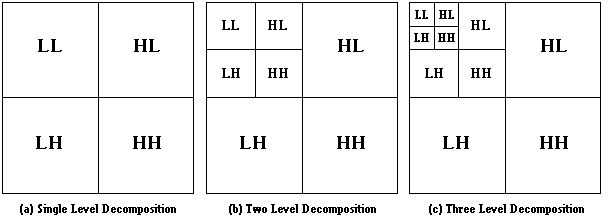One single level of a standard separable 2-channel wavelet transform, denoted by $i$, uses a low-pass $l$ and a high-pass $h$ filters (followed by downsampling). Traditionally, one applies $l$ and $g$ on the rows of the image, putting the downsampled low-passed coefficients on a left-half, and the downsampled high-passed coefficients on a left-half. Then the resulting image is processed in the same way column-wise.
This results in a set of four separable 2D filters:
- $l$ on rows, $l$ on columns (LL)
- $l$ on rows, $h$ on columns (LH)
- $h$ on rows, $l$ on columns (HL)
- $h$ on rows, $h$ on columns (HH)
producing the arrangement below. This is iterated (levels) for on the image, then on the low-pass/low-pass images (LL)

Among those filters, three (LH, HL, HH) can be considered as edge detectors ($h$ is similar to a 2-point gradient) in different directions: more horizontal (HL), more vertical (LH), somehow diagonal (HH).
The corresponding coefficients, as least their combined energy, can be interpreted as a measure of edge strength, a map computed for each level.
Remember that for a continuous 2D field modeling an image $f(x,y)$, the image gradient
$$\nabla f =\left[\frac{\partial f(x,y)}{\partial x} ,\frac{\partial f(x,y)}{\partial y} \right]^T$$
represents the local directional change in image intensities, whose norm is a measure of gradient "magnitude". You can compute several norms, the most common being the Euclidean, the Taxicab or the max norms.
The Haar filter $[1\,-1]$ is one possible discretization for the 1D gradient, the three 2D Haar wavelets compute an horizontal, a vertical and a somewhat diagonal gradient, hence their combined energy (Euclidean norm) is an estimate of the true gradient magnitude.

